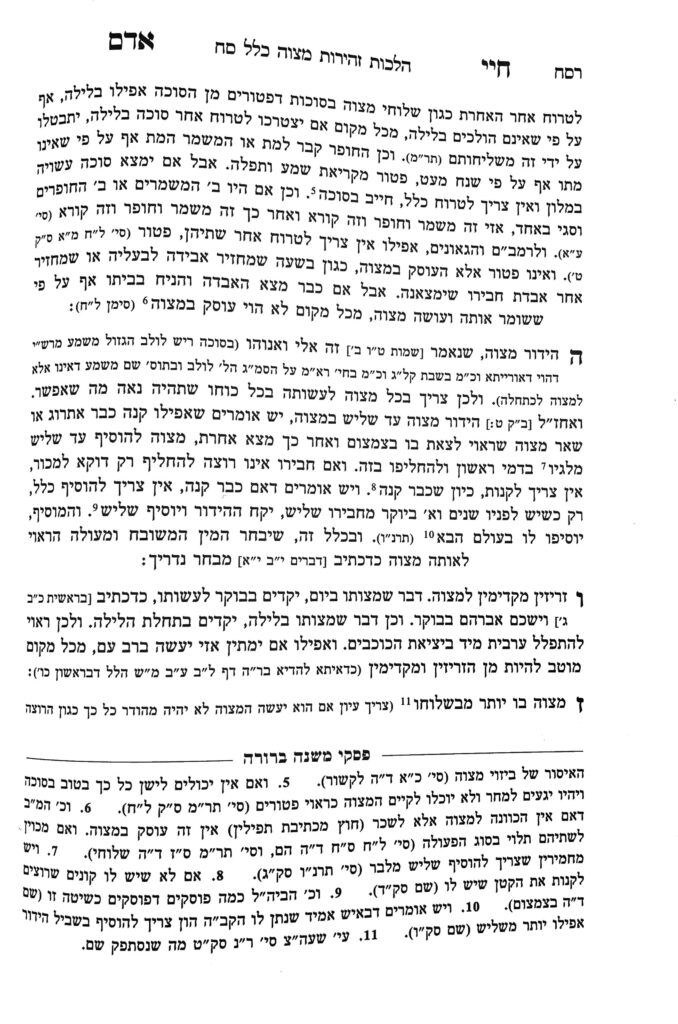1We are continuing in siman 4, discussing the concept of oseik bmitzvah patur min hamitzvah. There are many machlokos surrounding this concept, but one of the most famous is between Tosfos and the Ran in a situation where one can perform two mitzvos without one diminishing from the other. The Ran holds that once a person is osiek in the first mitzvah, they are patur from the second one even if its efshar lekayeim shneyhem (it is possible to fulfill both without detracting from the original mitzvah). Tosfos disagrees, and holds that if it is efshar lekayeim shneyhem, one is chayav to fulfill both. The Ran agrees that if there is absolutely no tircha in performing the second mitzvah, one would be chayav to perform both.
In siman 38, the Shulchan Aruch writes that people involved in writing tefillin or other STA”M articles are considered oseik b’mitzvah, and therefore are patur from krias shema, tefillah and other mitzvos. The Mishnah Berurah discusses the concept of osiek bmitzvah at length, and, in the Biur Halacha, proves that the Ran agrees that if there is absolutely no tircha in performing the second mitzvah, one would be chayav to perform both mitzvos.
He brings down the case of oseik b’mitzvah of the Gemara in Sukkah. The Gemara says that a chosson is patur from the mitzvah of sukkah during sheva brachos, because he is already involved in the mitzvah of being misameach his kallah. The Gemara asks why the simcha cannot take place in the sukkah, thus allowing for both mitzvos to be fulfilled. According to Tosfos, the question is understandable, as one could imagine that it is efshar lekayeim shneyhem. However, the Biur Halacha points out that according to the Ran that even when efshar lekayeim sheneyhem one is patur from the second mitzvah, it is difficult to understand the Gemara’s question.
The Biur Halacha answers that, according to the Ran, the Gemara’s question must have been assuming that there is absolutely no additional tircha involved in fulfilling both of the mitzvos (sukkah and simcha), and therefore the Gemara assumes in its question that one should be chayav to fulfill both. Thus, the Biur Halacha concludes that the Ran would agree that when there is absolutely no additional tircha, one would be chayav in both mitzvos.
Based on the agreement of the Ran and Tosfos in this case, the Rema writes in siman 38 that if it is possible to fulfill both mitzvos without tircha, one is mechuyav to do so.
According to the Ran, we can understand that the reason the Torah teaches the concept of oseik bmitzvah patur min hamitzvah twice is to teach that even when a person is able to do the second mitzvah, they are still patur. However, according to Tosfos, it is logical to assume that if one can perform both mitzvos without tircha they should, and there is no need for an additional pasuk to teach it. Therefore, the case where oseik bmitzvah is referring is a case where one can only do one of the two. Logically, one should just continue what they are doing already, so we need to clarify the position of Tosfos and how he understands the need for a limud to teach us oseik bmitzvah patur min hamitzvah.
Summary
Tosfos and the Ran argue whether oseik bmitzvah patur min hamitzvah applies when efshar lekayeim shneyhem. However, all agree that if there is absolutely no tircha involved in performing the second mitzvah, one is chayav to perform both.



